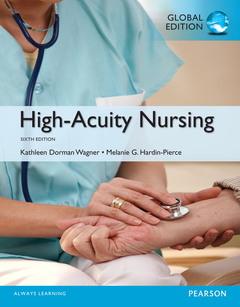Description
High-Acuity Nursing, Global Edition (6th Ed.)
Authors: Wagner Kathleen, Hardin-Pierce Melanie
Language: English
97.83 €
In Print (Delivery period: 14 days).
Add to cart976 p. · 21.6x27.6 cm · Paperback
Description
/li>Contents
/li>Comment
/li>
The most focused, up-to-date, easy-to-understand guide to high-acuity nursing in all care settings.
High-Acuity Nursing, Sixth Edition brings together the knowledge needed to care for adult patients with complex conditions and unpredictable outcomes, across settings ranging from critical care to high-skill long-term facilities. It makes critical pathophysiological concepts clinically applicable to high-acuity patients; enhances students? clinical decision-making skills; provides extensive and immediate feedback; and supports self-paced learning. This tightly focused guide has been substantially reorganized to reflect faculty and student feedback. This edition adds bulleted chapter summaries; NCLEX-style posttest items; updated Emerging Evidence boxes; coverage of oncological emergencies, hypertensive crises, and acute aortic problems; adult doses in Related Pharmacotherapy boxes; and a brand-new chapter on complications associated with metabolic stress response.
Teaching and Learning Experience
This book is designed to help learners rapidly gain mastery and confidence. It provides:
- Focused coverage of topics specifically related to high-acuity nursing: Helps learners gain command of crucial content without ever feeling overwhelmed by its volume and complexity
- Links pathophysiological principles and clinical care: Helps learners translate pathophysiological principles into care decisions, and understand the rationale for those decisions
- Learner-focused ?active learning? with strong pedagogical support : ?Chunks? complex information into small, discrete sections, provides quizzes after each section to ensure mastery, and offers extensive pedagogical support for more effective study
- I. Special Topics
- 1. High-Acuity Nursing
- 2. Holistic Care of the Patient and Family
- 3. The Older Adult High-Acuity Patient
- 4. Acute Pain in the High-Acuity Patient
- II. Hematologic (Cellular Function)
- 5. Determinants and Assessment of Hematologic Function
- 6. Alterations in Red Blood Cell Function and Hemostasis
- 7. Alterations in White Blood Cell Function
- 8. Alteration in Immune Response: Solid Organ and Hematopoietic Stem Cell Transplantation
- III. Pulmonary Gas Exchange
- 9. Determinants and Assessment of Pulmonary Gas Exchange
- 10. Alterations in Pulmonary Gas Exchange
- 11. Supporting Pulmonary Gas Exchange: Mechanical Ventilation
- IV. Cardiac Output
- 12. Determinants and Assessment of Cardiac Output
- 13. Assessment of Hemodynamic Status: Hemodynamic Monitoring
- 14. Assessment of Cardiac Rhythm: Basic Electrocardiographic Rhythm Interpretation
- 15. Alterations in Cardiac Output
- 16. Alterations in Myocardial Tissue Perfusion
- V. Tissue Perfusion
- 17. Determinants and Assessment of Oxygen Delivery and Oxygen Consumption
- 18. Alterations in Oxygen Delivery and Oxygen Consumption: Shock States
- 19. Alterations in Tissue Perfusion: Multiple Organ Dysfunction Syndrome
- VI. Neurologic
- 20. Determinants and Assessment of Cerebral Tissue Perfusion
- 21. Alteration in Cerebral Tissue Perfusion: Acute Brain Attack
- 22. Alteration in Sensory Perceptual Function: Acute Head Injury
- 23. Alteration in Sensory Perceptual Function: Acute Spinal Cord Injury
- 24. Sensory Motor Complications of Acute Illness
- VII. Fluid and Electrolyte Balance
- 25. Determinants and Assessment of Fluid and Electrolyte Balance
- 26. Alterations in Fluid and Electrolyte Balance
- 27. Alteration in Renal Function: Renal Failure
- VIII. Metabolic: Regulation of Internal Environment
- 28. Determinants and Assessment of Gastrointestinal, Hepatic, and Pancreatic Function
- 29. Alterations in Gastrointestinal Function
- 30. Alterations in Hepatic Function
- 31. Alterations in Pancreatic Function
- IX. Metabolic: Nutrition
- 32. Determinants and Assessment of Nutrition and Metabolic Function
- 33. Alterations in Metabolism
- 34. Alterations in Glucose Metabolism
- X. Tissue Integrity
- 35. Determinants and Assessment of Skin Integrity
- 36. Alterations in Skin Integrity: Complex Wound Management
- 37. Alterations in Skin Integrity: Acute Burn Injury
- 38. Alterations in Multisystem Function: Multiple Trauma
- GLOSSARY
- ABBREVIATIONS
- INDEX
- APPENDIX
Focused coverage of topics specifically related to high-acuity nursing:
- Tightly focused on the major problems and therapies frequently encountered in high-acuity patients—helping learners gain command of crucial content without ever feeling overwhelmed by its volume and complexity
- Illuminates topics that apply across all high-acuity problems—introducing core concepts of high-acuity nursing care, as well as important considerations in caring for high-acuity older adults
- Covers all facets of high-acuity care in all settings—including assessments, diagnostic testing, collaborative management, and more
- UPDATED! All chapters updated to reflect new findings and standards of care—with many chapters also reorganised to promote more efficient learning
- Expert coverage of complications of high-acuity illness—including multiple organ dysfunction syndrome and sensory motor complications
- Thoroughly covers therapeutic support of high-acuity patients —preparing students for supportive interventions including pain management, nutrition support, mechanical ventilation, hemodynamic monitoring, basic cardiac rhythm monitoring, and complex wound management
- Contains eight sections of coverage of the most common complex health problems, assessments, and treatments—preparing students to care for high-acuity patients with problems related to hematology, pulmonary gas exchange, cardiac output, tissue perfusion, neurology, fluid and electrolyte balance, metabolic regulation, nutrition, and tissue integrity
- NEW! Coverage of oncological emergencies, hypertensive crises, and acute aortic problems and crises—preparing students to handle a wider spectrum of medical events
- NEW! Adult dosages presented in Related Pharmacotherapy boxes —helping nurses part
These books may interest you

Advanced Critical Care Nursing 126.83 €



